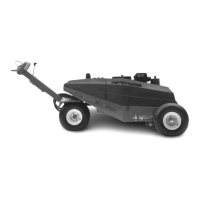25
Changing the Engine Oil and
Filter
For new engines, change the oil after the first 25 operating
hours. Thereafter, under normal conditions, change the oil
and filter after every 100 hours of operation. However, an
engine operated in dusty or dirty conditions requires more
frequent oil changes. If possible, run the engine just before
changing the oil. Warm oil flows more freely and carries
more contaminants than cold oil.
1. Position the machine on a level surface.
2. Disengage the hood latches and open the hood.
3. Place an oil drain pan below the drain cap on the
bottom of the crankcase (Fig. 20). Clean the area
around the drain cap.
4. Remove the drain cap and allow oil to flow into a drain
pan. After the oil has drained, install the oil drain cap.
1
Figure 20
1. Drain cap
5. Remove the oil filter (Fig. 21) and discard it.
Thoroughly clean the filter mounting surface and make
sure that a new gasket is installed in the new filter.
1
Figure 21
1. Oil filter
6. Apply a thin film of clean oil to the gasket. Install a
new filter by hand until the gasket just touches the
mounting surface, then turn the filter an additional 1/2
to 3/4 turn.
7. Remove the filler cap (Fig. 22) and pour approximately
3 quarts of oil having the API “service classification”
SF or SG into the filler neck. The recommended
viscosity (weight) of oil to use is SAE 30.
1
Figure 22
1. Filler cap
8. Start the engine and check for leaks around the oil filter.
Tighten the filter only enough to eliminate leaks. Do
not overtighten.
9. Turn off the engine and allow the machine to stand for 2
minutes.
10. Check the oil and make sure that the level is up to the
FULL mark on the dipstick. Add more oil if the level is
low; however, do not overfill.
11. Lower the hood and secure the latches.

